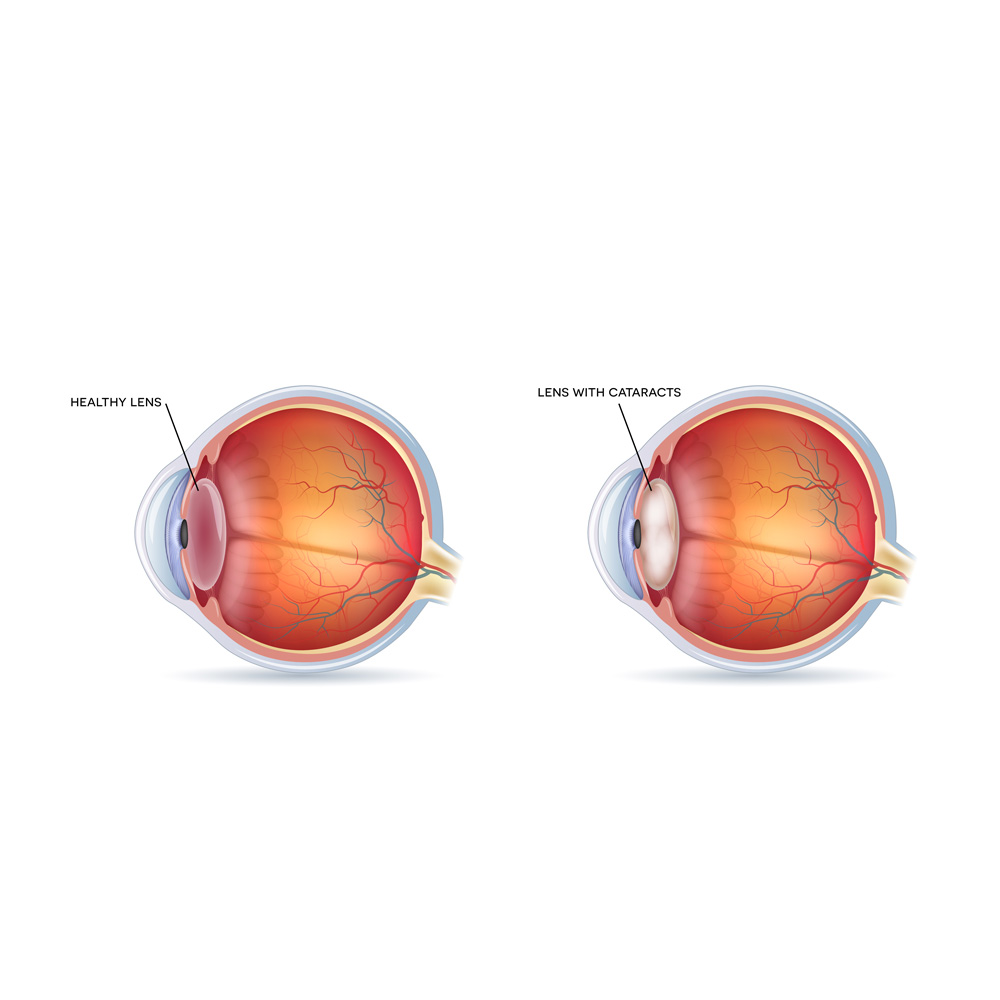What Are Cataracts?
A cataract is the clouding of the natural lens of the eye. The crystalline lens in our eye is clear and flexible at birth, which allows light to pass through into the eye and to see things clearly at different distances. As we age, our lens becomes progressively cloudy which causes light to scatter and visual clarity to decline.
Symptoms of cataracts are:
- Blurred vision
- Colors seem more faded
- Poor night vision
- Glare or halos around lights (especially bothersome during night time driving)
- Lights or sunlight may seem too bright
- Double vision in one eye
- Frequent changes in your eyeglass prescription
Who Gets Cataracts?
Your risk for developing cataracts increases as you get older. Most cataracts form gradually however, they can progress at different rates for everyone depending on the type of cataract and other risk factors. Conditions that increase a person’s risk for developing cataracts earlier are smoking, ultraviolet exposure, certain medical conditions like diabetes, and even some medications can lead to the formation of cataracts.
How are cataracts diagnosed?
Cataracts can be diagnosed as part of your comprehensive eye exam, which is recommended once a year. As part of the exam, your visual acuity will be tested and a refraction will be performed in order to quantify how well you can see. Your eyes will also be dilated (widening of the pupil) so your ophthalmologist can assess all the structures within your eye.
How are cataracts treated?
In early stages, before the lens of your eye has become too cloudy, cataracts can be corrected by changing glasses prescription and using brighter lights to read. If you are still symptomatic after these adjustments, cataract surgery will likely be recommended. Cataract surgery is an outpatient procedure where the cataract is replaced with a new clear lens. The majority of patients are awake during surgery, but a mild sedative is given to help relax you. The eye is anesthetized with drops and a small incision is made. A machine with ultrasound power is used to remove the cataract and a new intraocular lens is inserted. After surgery, the vision is slightly blurry but clears rapidly. Most activities can be resumed one day after cataract surgery.
Can a cataract come back once it’s removed?
A cataract cannot come back once it’s been removed. However, posterior capsular opacification, also know as a “secondary cataract” is a common condition that can occur after cataract surgery. This condition occurs when the posterior capsule (the membrane surrounding the natural lens which is intentionally left inside the eye) becomes cloudy, causing the vision to become blurred. This is easily treated with a laser called Yag capsulotomy in the office.
Who Gets Cataracts?
Your risk for developing cataracts increases as you get older. Most cataracts form gradually however, they can progress at different rates for everyone depending on the type of cataract and other risk factors. Conditions that increase a person’s risk for developing cataracts earlier are smoking, ultraviolet exposure, certain medical conditions like diabetes, and even some medications can lead to the formation of cataracts.
How are cataracts diagnosed?
Cataracts can be diagnosed as part of your comprehensive eye exam, which is recommended once a year. As part of the exam, your visual acuity will be tested and a refraction will be performed in order to quantify how well you can see. Your eyes will also be dilated (widening of the pupil) so your ophthalmologist can assess all the structures within your eye.
How are cataracts treated?
In early stages, before the lens of your eye has become too cloudy, cataracts can be corrected by changing glasses prescription and using brighter lights to read. If you are still symptomatic after these adjustments, cataract surgery will likely be recommended. Cataract surgery is an outpatient procedure where the cataract is replaced with a new clear lens. The majority of patients are awake during surgery, but a mild sedative is given to help relax you. The eye is anesthetized with drops and a small incision is made. A machine with ultrasound power is used to remove the cataract and a new intraocular lens is inserted. After surgery, the vision is slightly blurry but clears rapidly. Most activities can be resumed one day after cataract surgery.
Can a cataract come back once it’s removed?
A cataract cannot come back once it’s been removed. However, posterior capsular opacification, also know as a “secondary cataract” is a common condition that can occur after cataract surgery. This condition occurs when the posterior capsule (the membrane surrounding the natural lens which is intentionally left inside the eye) becomes cloudy, causing the vision to become blurred. This is easily treated with a laser called Yag capsulotomy in the office.
Premium procedures for cataract surgery
- Femtosecond Laser Assisted Cataract Surgery (FLACS)
FLACS is an innovative approach to cataract surgery which uses femtosecond laser technology to assist in cataract surgery with increased precision. The laser replaces steps of cataract surgery that was traditionally performed by hand. This personalized computer controlled laser uses 3-dimensional imaging to precisely perform certain critical steps of cataract surgery. The laser procedure is gentler on the eye and has been shown to decrease the amount of energy used inside the eye which leads to less post operative inflammation and discomfort and a faster recovery. The laser can also treat small amounts of astigmatism which will enhance a person’s refractive outcome and lessen the dependence on glasses. The laser allows for ultimate precision for enhanced, reproducible premium surgical performance and outcome. - Optiwave Refractive Analysis (ORA)
Intraoperative measuring and guidance technology which helps to optimize lens selection during cataract surgery. This technology is important to use during cataract surgery in people who have had LASIK/PRK and is useful to enhance refractive accuracy with other lens implants.
Lens Options
Lens Options
Monofocoal lenses (standard)
- Focus light from only one set point/distance
- Allow for clear vision without glasses (assuming you don’t have significant astigmatism)
- Most patients elect to have their vision set for distance vision
- Need glasses to focus at intermediate and near distances (computer and reading)
- Can consider mono vision (one eye focused at distance and the other eye focused at near)
- Covered by insurance
Multifocal lenses (premium)
- The newest technology available are multifocal lenses
- Designed to correct both distance and near vision
- Unique design which provides focusing capabilities at multiple ranges
- Not all patients are candidates (need consultation to determine if this technology is appropriate)
- Not covered by insurance
Toric lenses (premium)
- Corrects for astigmatism in patients who have cataracts and significant astigmatism
- Astigmatism causes blurry vision without glasses
- Astigmatism is caused by an uneven curvature of the cornea (steeply curved in one direction and significantly less curved in the other direction)
- Correcting both cataract and significant astigmatism gives clear and sharp vision
- Not covered by insurance



